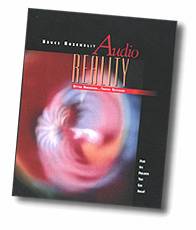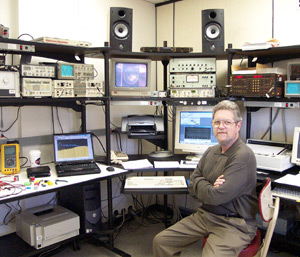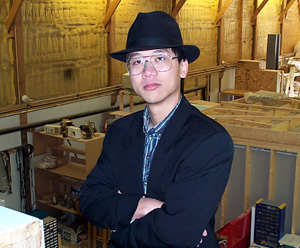![[SoundStage!]](../sslogo3.gif) Getting Technical Getting TechnicalBack-Issue Article |
May 2004 Exploring the Unique Sound of Tube Amplifiers It was as far back as the ‘60s when the new transistor or solid-state amplifiers replaced vacuum-tube amps, which were deemed too hot and -- due to a shorter life-expectancy -- too expensive. Capitalizing on their solution to these perceived weaknesses, solid-state amps quickly dominated the market. This left tube enthusiasts a very small minority; however, even in the year 2004, this seemingly outdated technology claims dedicated fans. Why do some listeners still prefer tubes? The answer is simple: the sound. Tube sound is unquestionably unique. How it differs, and why it differs from solid-state, is the focus of this article.
I first interviewed Bruce Rozenblit, electrical engineer, designer, and owner of the high-end tube-amplifier manufacturer Transcendent Sound. Rozenblit has been an audiophile since the age of ten and is also the author of the Beginner's Guide to Tube Audio Design and Audio Reality. I asked him why such a qualified designer would devote his energies to tubes and not newer, more cutting-edge audio technologies. "I enjoy tube amplifiers because they are fun to work with," says Rozenblit. "The technology basically died in the early ‘60s, so most manufacturers focused their attention elsewhere and assumed everything that could have been done had been done. That wasn't the case. There are still new things that can be done and new circuits that can be developed. Just because it's an old technology doesn't mean it’s invalid. Think of a furniture manufacturer who builds with his hands compared to furniture manufactured in a factory. That handmade furniture will last a lifetime." The "old way" began almost a hundred years ago when, in 1907, Lee de Forest patented his Thermionic Vacuum Tube, which was a device used to amplify electrical currents. De Forest's invention improved radio and telephone service, and eventually led to the creation of television and audio amplifiers. Since these amps were used to boost the sound of guitars, some have even credited De Forest with creating rock’n’roll. Aside from enjoying working with the technology, Rozenblit believes some people still prefer tube amps because of their sound. "Compared to solid-state, tube amps reproduce sounds completely differently and therefore give you a unique experience." Traditional tube sound can be described as warm, with fuller-sounding bass, and a sense of space even when music reaches high levels. (Many modern tube-amp designers, like Rozenblit, say their current designs are much more neutral-sounding compared to tube amps of decades ago. "The 'warmth' characteristic can be designed out if one knows how," says Rozenblit.) On the other hand, complain enthusiasts, while solid-state amps provide undeniably cleaner sound, they have no air or depth. "Solid-state amplifiers," explains Rozenblit, "are current amplifiers whereas tubes are voltage-amplifying devices and have lower input capacitance. They also have their own set of microphonics that are unique to the sound and that add seasoning." Russell Hamm: Tubes versus transistors Critics of tubes have another explanation. When you listen to tubes, you listen to distortion. However, Rozenblit points out that his tube amps have very low distortion compared to that generated by loudspeakers. Furthermore, tubes and solid-state amps alike produce distortion. It took some digging, but I eventually found a paper that had another explanation for the uniqueness of tube sound. In 1973, Russell Hamm published "Tubes versus transistors -- is there an audible difference?" in the Journal of the Audio Engineering Society. What Hamm discovered was that, when distorted, both tubes and transistors sounded distorted and when in their normal, non-overload range they both sounded very clean. The differences are a matter of when the overload ranges would occur. Transistors would normally have an overload range of 10dB whereas tubes had a range of 20dB or more. "The overload margin varies widely between different types of amplifiers… It may be concluded that these inaudible harmonics in the early overload condition might very well be causing the difference in the sound coloration between tubes and transistors." Hamm did not stop there, but also investigated the relationship between the electronic distortion and musical-tone coloration. He found that the distortion between tubes and transistors differed in their harmonic distortion. "The basic cause of the difference in tube and transistor sound is the weighting of harmonic-distortion components in the amplifier's overload region. Transistor amplifiers exhibit a strong component of third harmonic distortion when driven into overload. This harmonic produces a covered sound, giving the recording a restricted quality. Alternatively, a tube amplifier when overloaded generates a whole spectrum of harmonics.... These add edge to the sound, which the ear translates to loudness information."
Hamm's results shed a lot of light on why tubes sound the way they do. However, there is more to the story than simply how the amps react to overload. Amps are directly connected to loudspeakers, and how they interface also contributes to the uniqueness of tube sound. Paul Barton of PSB Speakers took the time to explain. "Tube amps create a different sonic experience from solid-state amps because they have high output impedance. For example, most solid-state amps have an output impedance of 0.0001 ohms, while a tube amp will have an higher output of 1 ohm or more." Barton continues, "Most speakers are designed for the lower impedance of solid-state, the more common amplifiers. What this means is that when a tube amp is used, the higher impedance causes changes in the frequency response. This more greatly affects low-to-midrange frequencies, so a warmer sound occurs with the tube amps. Some speakers try to match with amps that produce different impedance; they have 'taps' that can be adjusted to balance off current and voltage demands." "Personally, I design speakers with very flat impedance so even with a tube amp the speaker's frequency response is not altered. But even if tube and transistors have flat frequency response, the speakers will sound different and have different frequency response depending on the type of amp used. I don't prefer tubes because I'm interested in reproducing sound as nearly identically as I can. The sonic experience created by tubes is not true to nature because it is modifying the sound even if this sound is pleasant."
Whereas Paul Barton wishes to re-create reality, Gilbert Yeung, owner of Blue Circle Audio and designer of "hybrid" amplifiers, believes that the goal of audio design is to create what is perceived as great sound. "The sonic experience," says Yeung, "is 50% the listening experience and 50% measurement." Regardless of what frequency-response curves demonstrate, Yeung, an audiophile since the age of ten, enjoys good sound with a hint of the warmth produced by tubes. However, Paul Barton raised an important point: most speakers are not designed for use with tubes. But what if one prefers the warmth of tube sound? The solution is one of Yeung's hybrid amplifiers. Blue Circle Audio is located only 30 minutes from my home in London, Ontario, so I was able to meet with Yeung personally. His hybrid amps use tubes for the pre-driver section and transistors for the output section of the amp. Yeung explains his thinking. "Tubes are voltage devices. Voltage devices are good for voltage-gain stages, so I use them in the gain/pre-driver, which is before the output stage and drives the output. I prefer to use tubes because they are more linear in terms of voltage swing. With their higher voltage supply, tubes can easily produce much higher output than transistors can." Yeung continues, "Since the interface between tubes and speakers affects final output, I use solid state because it is a current-gain device and can control the speakers better. You could say that tubes with solid-state output 'talk' to the speaker better than a tube with a transformer." "I agree [with Barton]," Yeung continues, "about the effect impedance has on overall sound. Speaker impedance swings up and down a lot in reality, even though it should be flat on paper. Damping factor equals speaker impedance/output impedance of a power amp. Let’s say that a tube amplifier with transformer has an output impedance of 4 (using 4-ohm output taps), and let’s say that the speaker impedance range is between 6 and 3. Then the maximum damping factor of this combination is 6/4=1.25, and the minimum damping factor is 3/4=0.75. With a transistor design, the output impedance is much lower, typically 0.1, so with the same impedance range, the maximum damping factor is now 6/0.1=60 and the minimum is 3/0.1=30." "You have to balance the damping factor because if it’s too high the sound will be sterile and if it’s too low the clarity is lost -- in fact, some people like this [latter] sound; it's the warmth that tubes are known for. But you can always get a higher damping factor with solid state." Tu-be or not tu-be: In conclusion There are many factors that go into any discussion of tube amplifiers, and this article has just briefly touched upon some of the main topics surrounding the unique sound of tubes. The preference for tubes is just that, a preference. Either one enjoys the added harmonics of tubes compared to the "cleaner" solid-state sound, or one doesn't. Nevertheless, one can’t help concluding that there must be something special about tube sound for it to endure decade after decade. ...Alison Aulph
|
|
![[SoundStage!]](../sslogo3.gif) All Contents All ContentsCopyright © 2004 SoundStage! All Rights Reserved |
 Transcendent
Sound’s Bruce Rozenblit: "Why I love tubes"
Transcendent
Sound’s Bruce Rozenblit: "Why I love tubes" PSB’s Paul Barton: The
relationship between loudspeakers and amplifiers
PSB’s Paul Barton: The
relationship between loudspeakers and amplifiers Blue Circle’s
Gilbert Yeung: The best of both worlds
Blue Circle’s
Gilbert Yeung: The best of both worlds